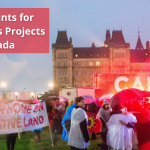THE GHG GRANT PROGRAM: AN OVERVIEW
The GHG Grant Program for Buildings and Industry is providing funding for businesses, associations, and organizations who want to undertake project and initiatives that will lower Greenhouse gas emissions. The grant is one of many financial commitments by the government of the North West Territories to help create a cleaner, greener Canada.
The GHG Grant for Buildings and Industry is available to businesses, industry, and non-profit organizations in the North West Territories. The program is designed to support projects and initiatives that will directly reduce greenhouse gas (GHG) emissions. Recipients for the program are chosen through an application process, and applications are competitive. There is a total of $2, 700, 000 dollars in funding available and the program is open until March 31st, 2024.
The program is designed to ‘fill in the gap in funding for larger GHG reduction initiatives’. As such, the government is only considering projects that have a project minimum cost of $100 000. Funding will only cover ELIGIBLE PROJECT EXPENDITURES (up to either 25% or 40% depending on the applicant), so it’s important to understand which project expenditures are covered under the grant.
Both resources and funding for the GHG Grant Program for Buildings and Industry have been provided jointly by:
- The GNWT in support of the GNWT’s 2030 Energy Strategy, and
- Environment and Climate Change Canada (ECCC), under the Low Carbon Economy Leadership Fund (LCELF) in support of the Pan-Canadian Framework on Clean Growth and Climate Change.
There are a wide variety of projects that are eligible for the grant. Projects might include, but are not limited to:
- Electric Vehicle Charging Stations with firm GHG reduction potential
- Off-grid renewable electricity
- Building energy retrofits
- Waste-to-energy and methane capture and use
- Renewable energy for space or water heating
- Initiatives that turn waste into energy
Proposals for the grant are competitive because there is a maximum amount of money available through the program. Projects and initiatives that will result in a ‘greater GHG emission reduction per grant dollar’ will be given preference and will have a higher likelihood of being chosen. To increase your chances of a successful application, we’ve highlighted the main requirements and criteria for the grant in this article.
HOW MUCH MONEY CAN ELIGIBLE PROJECTS RECEIVE?
The GHG Grant Program for Buildings and Industry does not offer FULL funding. Applicants of the grant MUST fund part of the cost of the project or initiative. Furthermore, funding given for recipients of this grant cannot combine any other sources of federal funding ‘under the Pan-Canadian Framework on Clean Growth and Climate Change (PCF). If applicants of this grant are receiving any other type of federal funding under PCF, then they are ineligible for funding.
With that being said, eligible projects can receive a substantial amount of funding under the GHG Grant Program for Buildings and Industry. The amount of money available depends on the entity applying.
- Businesses and industry applicants may receive up to 25% of eligible project costs.
- Non-profit applicants may receive up to 40% of eligible project costs.
WHEN IS THE APPLICATION DEADLINE?
For the Fiscal Year April 1, 2022 to March 31, 2023:
- The application period opens on JANUARY 1, 2022.
- The Completed Application Deadlines are: March 1, 2022, July 1, 2022, and November 1, 2022
For the Fiscal Year April 1, 2023 to March 31, 2023:
- The application period opens on JANUARY 1, 2023
- The Completed Application Deadlines are: March 1, 2023 and July 1, 2023
WHO IS ELIGIBILE FOR THE GRANT?
Eligibility and the amount of money available is divided into for-profit, and non-profit organizations, businesses, and associations. Non-profit organizations and associations can receive more money than profit organization, businesses, and associations.
- Canadian non-profit associations and organizations can receive up to 40% of eligible costs.
- Canadian for-profit organizations with established businesses in Canada, and Canadian individuals can receive up to 25% of eligible costs.
*Remember, this grant is designed to help associations, organizations and businesses in the North West Territories take on projects and initiatives that will reduce GHG emissions. Some projects and initiatives are bigger and more expensive than others. For example, retrofitting an individual home is far less expensive than retrofitting fleet vehicles and this grant is designed to provide funding for large, expensive projects with a minimum project cost of $100 000. So the very first criteria of eligibility is whether or not your project meets that minimum project cost.

WHAT PROJECTS ARE ELIGIBLE?
The GHG Grant Program for Buildings and Industry will only provide funding for projects and initiatives that directly reduce GHG emissions. We’ve listed the eligible projects here for your reference. This list was taken directly from the GHG Grant Program Guide for Building and Industry on the government website.
ELIGIBLE PROJECTS ARE:
- Institutional, residential or commercial scale biomass heating that displaces fossil fuels.
- Off-grid renewable electricity.
- Fuel switching that results in GHG reductions.
- Renewable energy projects for space or water heating.
- District heating systems for new and existing buildings based on residual or renewable heat sources.
- Combined heat and power, where heat is the primary energy output.
- Waste-to-energy, and methane capture and use.
- Building energy management systems.
- Building energy retrofits.
- Retrofits to mobile equipment and fleet vehicles, such as heavy equipment, boats and marine vessels, fire equipment, fleet vehicles such as light cars and trucks that reduce GHG emissions.
- Incremental biomass energy installation costs for new buildings.
- Electric Vehicle Charging Stations with firm GHG reduction potential
*Please note – there may be some projects that are eligible that are not on this list. If you have a project that you think might be eligible, you can discuss it with a GNWT GHG Grant Coordinator.
Understanding which projects are eligible is an important part of the process. After all, you won’t receive funding if your project is NOT eligible, which is why we have also included a list of projects that are INELIGIBLE for funding under the grant.
INELIGIBLE PROJECTS ARE:
- Any project or initiative that does not result in GHG emissions reductions.
- The purchase of mobile equipment and fleet vehicles.
- Renewables such as solar or wind energy to produce electricity on grid.
- Building certification, such as LEED or BOMA Best, ISO 140XX, etc.
- Research, development and demonstration (RD&D) elements.
- Standalone educational or capacity building elements.
- Energy planning.
- Stand-alone feasibility study, engineering studies or other prospective studies: The project cannot be dependent on any preliminary studies aimed at informing the decision of whether or not to go forward with the initiative. Such studies must be completed before the Formal Proposal is submitted.
- The construction of new buildings: The Program will not fund projects for which GHG emissions reductions are achieved based on the construction of new buildings (e.g., reductions stemming from building beyond code or via carbon sinks in wood buildings)
Read More: 8 Ways to Save Energy with Your Furnace
CRITERIA FOR EVALUTION AND REQUIREMENTS
The program is competitive, with a finite amount of funding available. The government website has listed a very specific set of criteria that will be used to assess your application. So, to increase your success of receiving funding under the program, pay close attention to this criteria. This criteria is the cornerstone of the grant, and your whether or not you receive funding is based on how well your project meets this criteria.
The Main Criteria for Application Evaluation:
- GHG emissions reductions per dollar of grant awarded.
- Project feasibility and likelihood of success and completion
- Capacity of the individual, team, or organization undertaking the project initiative
- Quality of completeness of the proposal including financial information and budget, project plan, business plan, timelines, risk management
Based on this list of criteria, questions perspective applications might want to aske themselves are:
- Does my project reduce GHG emission?
- Is it likely that I can complete this project?
- Is this project practical?
- Am I, or is my team, able to undertake this project?
- Is my proposal complete? Is it organized? Does it provide all the information the GNWT needs to make the best decision about my funding?
*It is important to note that the criteria for application evaluation is NOT the same of project eligibility. This criteria is WHAT your proposal and application will be evaluated on. For example, Project A and Project B are both applying for the grant. Both projects are ELIGIBILE under the project eligibility list. But Project A will reduce more GHG emissions per dollar of grant awarded than Project B. Project A also have a very solid business plan that outlines in detail budgets, timelines, and other financial information. Project B, on the other hand, will also reduce GHG emissions (because that is a requirement for eligibility); however, Project A will reduce MORE GHG emissions per grant dollar than Project B. Project B also has a vague business plan.
So, when both applications are being evaluated, Project A will be given preference over Project B because Project BETTER fits the criteria. Projects and initiatives that BEST fit the criteria will be more likely to receive funding than ones that don’t, so it’s in your best interest to pay close attention to the application evaluation criteria.
WHICH EXPENDITURES ARE ELIGIBLE FOR THE GRANT?
The GHG Grant for Buildings and Industry will provide funding for ELIGIBLE Expenditures. Under the GHG Grant Program, not all expenditures are considered equal. ONLY eligible expenditures can receive funding. So it’s important to under WHICH expenditures are available for funding.
To help you, here is a list expenditures that are eligible for the Program.
- Management and professional service costs. These cost include things like accounting costs, communication costs, official language translation (where needed), audit charges, estimate verification for GHG emissions reductions and cost-per-tonne
- Planning and feasibility work, as long as the planning and work are part of a project or initiative that will lead to direct GHG emissions
- Material and supply costs
- The costs of printing, production, and distribution
- Equipment and capital assets purchase or rental
- Vehicle rental and operation costs
- Costs involved with contractors who are required to perform activities that are directly related to the project
- Any GST/HST that is not reimbursable by the Canada Revenue Agency (CRA)
- Incremental human resource costs, including salaries and benefits
- Other miscellaneous costs, so long as the GNWT deems them to be NECESSARY and DIRECT for successful implantation of a project, and so long as the costs have been approved by the GNWT in writing, PRIOR to being incurred.
*If you are unsure about any of your eligible expenditures, you can discuss your concerns with your GHG Grant Program Coordinator. You must discuss these costs BEFORE you incur them. Some costs that exist in a gray area (questionable costs) might not be reimbursed, so it’s best to ensure that your costs are eligible before you dole out the money.
As mentioned, not all expenditures are eligible, so it is equally important to understand which expenditures are NOT covered by the grant.
WHICH EXPENDITURES ARE NOT ELIGIBLE?
Ineligible expenditures are:
- Costs that are incurred for withdraw or cancelled program or initiative
- Land acquisition costs
- Leasing land, buildings and other facilities
- Leasing equipment other than equipment directly related to the construction of a project
- Real estate fees and related costs
- Financing charges, legal fees, and loan interest payments, including those related to easements
- PST/GST/HST, where the Recipient is eligible for a rebate, and any other costs eligible for rebates
- Maintenance or operational costs
APPLICATIONS FOR THE GHG GRANT FOR BUILDINGS AND INDUSTRY
Once you have established that you are eligible to receive funding, that your project is eligible to receive funding, and that your expenditures for your project are eligible to receive funding, then it’s time to move on to the application.
Applications are accepted on a continuous basis, however, to be assigned to the next available review period, the application must be complete. Please note the application deadlines listed early in this article. Applications must be COMPLETED by the deadline, so review the deadline and ensure you give yourself enough time to complete the application. It’s better to have all your ducks in a row and waiting, then it is to be scrambling for ducks at the last minute.
As with a lot of governments grant, the application for the GHG Grant for Buildings and Industry is long and involved. Review these application requirements well in advance, and make sure you understand all the requirements beforehand.
APPLICATION REQUIREMENTS
The GNWT will require the following information to fulfill application requirements:
You will need to submit all the following before your application is deemed complete. And remember, only completed applications will be evaluated.
- You will need to submit a completed and signed application with declaration and consent section that is signed and dated.
- You will need to submit a detailed project proposal using the Application Proposal Template provided in Section 18 and/or a business plan, if available. (We discuss this project proposal in more detail following this section.
- If you are a business, then you will need to submit proof that the business is legally able to operate in the NWT. If your business is a non-profit entity, then you will need to submit proof of status is required.
- You will need to submit documentation of required permits, business license, and agreements with partners
- You will also need to submit any other information deemed necessary by the GHG Grant Program Coordinator to evaluate the application.
THE PROJECT PROPOSAL
The project proposal is the most important part of your application, so we’ve provided more details about it in this section.
To be considered for funding, applicants MUST submit a PROJECT PROPOSAL. There is detailed template available on the government website, but here is an overview of what you need to include in your project proposal.
Name of the Project: The project name should be ‘descriptive’ but short. Describe your project in as few words as possible. The GNWT will identify your project by this name, and this project name will also be used in public announcements once the project is approved.
Recipient Name: You will need to identify the recipient type here.
Short Description of the Project: This section is ‘short’, so it should only contain highlights from the next section. *A tip for writing this section is to write the next section (the Detailed Project Description) first, pull out the main points and then write this section.
Detailed Project Description: Start by introducing the project, and then give the following details. From this section, the reader should have a pretty solid understanding of the project as a whole. Some of the details you will be required to submit are:
- What is going to be done?
- Who is going to do it?
- What are the benefits of the project?
- Where is the equipment going to be installed? You can include a map of the community buildings or locations here, as well as a description.
- What are the processes needed to complete the project? The equipment required? The technology needed?
- What are the anticipated cost saving?
- This section will also include a business plan, and documentation such as permits and business licences
GHG Reductions: This is where you demonstrate HOW this project fulfils the main project criteria. You will include methods that you will use to measure/estimate/calculate, track, and report GHG emissions reductions. • *Remember, this is one of the main criteria, so applicants must be able to demonstrate how their project fulfils this criteria.
Project Timeline: You will list and describe the major milestones of the project here, including the estimated date of completion.
Project Team: Time to meet the team! You will write a short summary of the project lead and the project team here, as well as any contractors or suppliers that have already been pre-chosen.
Project Budget: There is a list of categories that the project expenses should be divided into. You can find this list on the website, but to give you an idea, some categories include:
- Materials and supplies
- Printing, production and distribution
- Human resource cost, like salaries and benefits
- Management and professional services
If you have physical quotes for some of these categories, include them! Estimate the rest to the best of your ability.
Funding Sources: Remember, the funding does not cover the costs of the ENTIRE project, so this section asks you disclose all funding sources.
Final Comments or Other Relevant Information: If you think you have some additional information that will help your application be approved, then include it here. Remember, the application is, in essence, your chance to convince the GNWT that your project is the ideal project for funding. The more relevant information you can give them, the better, as long as you present information in a concise way. So if you have more information to give, information that might persuade them, or allow them to gain a better understanding of your project, then go ahead and include it here.
WHAT CAN I DO TO INCREASE MY CHANCES OF BEING CHOSEN?
TIPS FOR APPLYING:
To increase your chances of a successful application, here are some things you can do:
- Ensure that your project is eligible. Your project must have a minimum project cost of $100 000. And, the grant is for projects and initiatives that will directly lower GHG emissions, so make sure that is the main objective of your project. IF it is not, then their might be other government grants available for you project. You can find a lot of different government grant resources on our website: https://showmethegreen.ca/
- Review the Application Evaluation Criteria. The better your project fits this criteria, the better your chances of receiving funding.
- Understand which expenditures are ELIGIBLE for funding. Not everything you spend money on qualifies for funding, so it’s in your best interest to know before-hand which costs are eligible and which aren’t.
- Collect everything you need for the application. Remember, there are application deadlines, and you want to make sure you meet those deadlines.
- Complete the application, with special attention paid to the project proposal section.
READY TO APPLY?
For more information, or to start your application for the GNWT’s GHG Grant Program for Building and Industry, visit:
https://www.inf.gov.nt.ca/en/services/energy/ghg-grant-program-buildings-and-industry






Leave a Reply